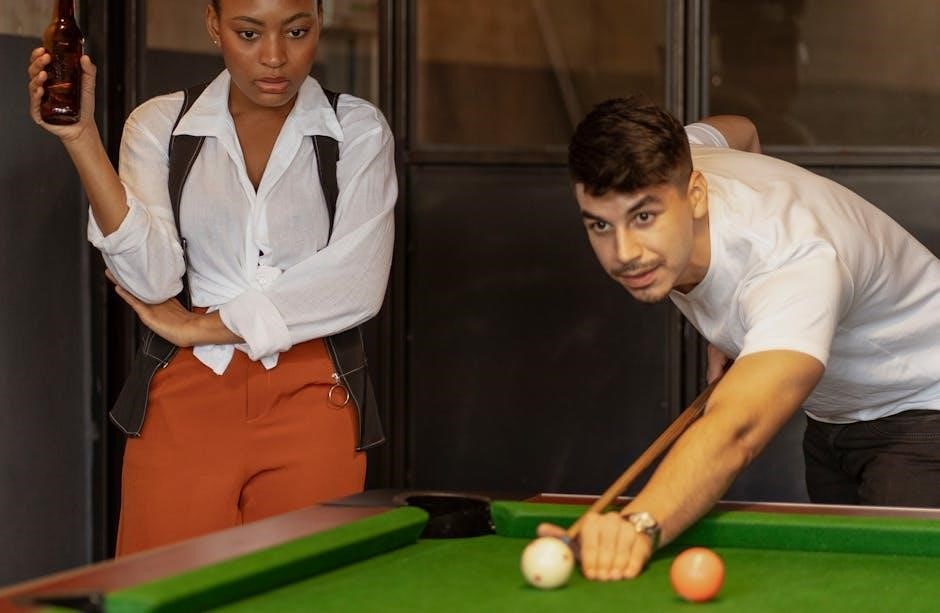Choosing the right pool cue size is crucial for optimal performance. This guide explores key factors like player height, table size, and personal preference to help you select the perfect cue.

1.1 Importance of Proper Cue Size
Proper cue size is essential for optimal performance and comfort. A cue that fits your stature, playing style, and table size ensures better accuracy and consistency. Incorrect sizing can lead to discomfort, affecting your stance and grip, which may result in miscues and poor control. Players with cues that are too short or too long often struggle with maintaining a consistent stroke. The right size enhances your ability to strike the ball accurately and apply English effectively. Additionally, it reduces fatigue during extended play. Choosing a cue that matches your needs improves your overall gaming experience and confidence. Proper sizing is a foundation for mastering pool and cue sports.
1.2 Brief Overview of Pool Cue Dimensions
Pool cues vary in dimensions, with length, weight, and tip diameter being the primary factors. Standard cues typically range from 57 to 61 inches in length and weigh between 18 and 21 ounces. The tip diameter usually ranges from 11 to 14 millimeters. These dimensions are designed to suit different players’ needs, depending on their height, reach, and playing style. Materials like wood, fiberglass, or graphite also influence the cue’s overall feel and performance. Understanding these dimensions helps players select a cue that aligns with their preferences and enhances their gameplay. Properly matched cues improve accuracy, control, and comfort during play.
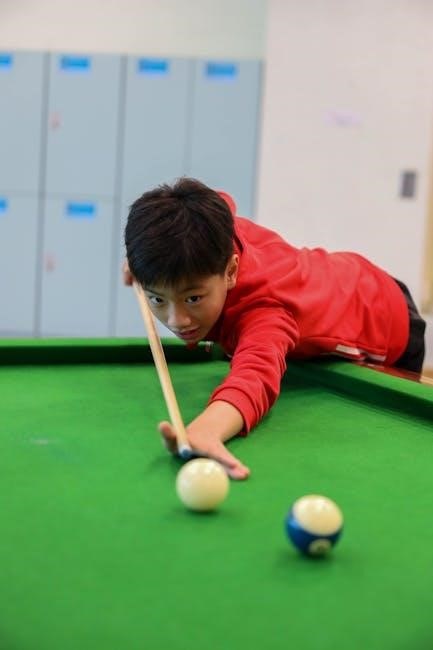
Factors Determining Pool Cue Size
The size of a pool cue is determined by the player’s height, arm length, table dimensions, and playing style, ensuring optimal control and accuracy.
2.1 Player’s Physical Stature and Wingspan
A player’s height and wingspan significantly influence pool cue size. Taller individuals typically require longer cues to maintain proper stance and alignment, while shorter players benefit from shorter cues for better control. Wingspan, or arm span, also plays a role, as it affects how far a player can reach and strike the ball comfortably. A cue that matches the player’s physical dimensions ensures consistent performance and reduces fatigue. For example, players with a taller stature or longer arms may prefer cues around 58-61 inches, while shorter players might opt for cues closer to 48-52 inches. Proper fit enhances accuracy and overall playing comfort.
2.2 Table Size and Type
Table size and type are crucial in determining the appropriate pool cue length. Larger tables, such as those used in snooker or carom, require longer cues to accommodate the increased distance between shots. Smaller tables, like those in recreational pool, work better with shorter cues for precise control. The table’s dimensions influence the cue’s length and weight, ensuring optimal performance. For example, a 7-foot pool table typically pairs with a 57-58 inch cue, while a 9-foot table may need a 58-61 inch cue. Matching the cue to the table size enhances accuracy and power, preventing discomfort or difficulty in reaching shots. Proper alignment is key for consistent play.
2.3 Playing Style and Grip Preferences
A player’s style and grip preferences significantly influence pool cue size selection. Players with an aggressive stroke may prefer a heavier cue for added power, while those with a smoother, more controlled style might opt for a lighter cue. Grip size is also important; a thicker grip can provide stability for players with a strong stroke, while a thinner grip suits those with a more precise touch. Additionally, cue balance—where the weight is distributed between the butt and shaft—affects performance. Some players prefer a forward balance for better control, while others like a rear balance for more power. Customization options, such as interchangeable tips or adjustable handles, can further tailor the cue to individual preferences, enhancing overall playing comfort and consistency.

Pool Cue Length
Pool cue length is crucial for accuracy and control. Standard cues are 57-61 inches, but lengths vary based on table size, player height, and personal preference.
3.1 Standard Cue Length
The standard length of a pool cue typically ranges between 57 and 61 inches. This length is designed to accommodate the average player’s height and stance, providing optimal control and balance. Most cues are manufactured to this specification, as it suits a wide range of players and table sizes. The 57-61 inch range allows for precise alignment and stroke execution, making it ideal for both recreational and competitive play. While some players may prefer slightly shorter or longer cues, the standard length remains the most common choice for its versatility and performance. Customization options are available for those with specific needs.
3.2 Adjustments for Different Table Sizes
Table size significantly influences the ideal pool cue length. Larger tables, such as those used in snooker or professional tournaments, often require longer cues (58-61 inches) to accommodate the greater distance between shots; Conversely, smaller tables, like those found in bars or homes, may be more manageable with shorter cues (54-57 inches). The cue length should allow the player to strike the cue ball comfortably while maintaining control over the cue’s balance. Adjusting the cue length based on table size ensures better accuracy and reduces strain during play. Proper alignment and stroke consistency are easier to achieve when the cue is proportionate to the table’s dimensions, enhancing overall performance. Always consider the table size when selecting a cue for optimal results.
3.3 Cue Length for Players of Different Heights
A player’s height plays a crucial role in determining the ideal cue length. Taller players typically require longer cues to maintain proper stance and alignment, while shorter players benefit from shorter cues for better control. Generally, players under 5’6″ may prefer cues around 54-56 inches, while those between 5’6″ and 6’0″ often find 57-59 inches comfortable. Taller players (over 6’0″) may opt for cues between 60-61 inches. However, arm length and stance also influence this, as some taller players with shorter arms may prefer shorter cues. Measuring the cue while standing upright with the cue resting against the shoulder can help determine the most comfortable length. This ensures optimal balance and accuracy, catering to individual physical characteristics. Personal preference and comfort should always take precedence, as every player’s needs may vary slightly. Proper fit enhances performance and reduces fatigue during extended play sessions. Always consider both height and ergonomics when selecting a cue length. This tailored approach ensures better alignment and stroke consistency, which are critical for precision and control in pool games. By matching cue length to a player’s height, they can achieve a more natural shooting position and improve their overall game. This customization is essential for maximizing potential and enjoying the game fully.
Cue Tip Diameter
Cue tip diameter affects accuracy and control. Standard sizes range from 12mm to 14mm, with smaller tips offering better control and larger tips providing a softer hit.
4.1 Common Tip Sizes
Cue tip diameters typically range between 12mm and 14mm, with 12mm to 13mm being the most common for pool cues. A 12mm tip is ideal for precise control and accuracy, often preferred by skilled players. The 13mm size offers a balance between control and power, making it a popular choice for recreational and competitive play alike. Larger tips, such as 14mm, are less common but provide a softer hit, reducing cue ball deflection and are often used by players who prioritize power over finesse. The choice of tip size depends on personal preference, playing style, and the type of cue sports being played.
4.2 Choosing the Right Tip Size for Your Game
Selecting the appropriate tip size is crucial for optimal performance. Players with a more precise stroke or those who prioritize accuracy often prefer smaller tips, such as 12mm. Larger tips, like 13mm or 14mm, are better suited for players who generate more power or play on larger tables. Beginners may benefit from a slightly larger tip for consistency, while advanced players might opt for smaller tips to reduce cue ball deflection. Ultimately, the choice depends on your skill level, playing style, and the specific requirements of your game. Testing different tip sizes can help determine which one aligns best with your technique and goals.
Cue Weight
Cue weight significantly impacts playability and balance. Standard cues weigh 18–21 ounces, with lighter cues offering better control and heavier cues providing more power. Weight choice depends on the player’s strength, stroke style, and personal preference, ensuring optimal performance and comfort during gameplay.
5.1 Standard Weight Range
The standard weight range for pool cues is typically between 18 and 21 ounces. This range is widely accepted as it provides a balance between control and power for most players. Lighter cues, around 18–19 ounces, are ideal for players who prefer precision and a softer touch, while heavier cues, closer to 21 ounces, offer more power for breaking shots or longer table play. The choice within this range often depends on the player’s size, strength, and personal preference. A cue that is too heavy can cause fatigue, while one that is too light may lack the necessary force for certain shots. Comfort and performance are key factors in selecting a cue within this standard range.
5.2 Weight Adjustments for Table Size
The size of the pool table can influence the optimal weight of the cue. For smaller tables, such as 7-foot bar tables, a lighter cue (around 18–19 ounces) is often preferred, as it allows for better control and precision. Larger tables, like 9-foot tournament tables, may benefit from a slightly heavier cue (20–21 ounces) to generate more power for long shots. The weight adjustment ensures that players can strike the ball with the necessary force without sacrificing accuracy. Additionally, the table’s size and the distance between the balls can influence how much weight is ideal, as heavier cues can help with momentum over longer distances. Balancing table size and cue weight enhances overall performance and comfort during play.
Cue Materials and Construction
Cue materials and construction vary widely, impacting performance and durability. Maple, fiberglass, and graphite are common materials, each offering unique benefits in terms of feel and consistency.
6.1 Types of Materials Used
Pool cues are crafted from a variety of materials, each offering distinct advantages. Maple wood is the most common, prized for its balance and clear feedback. Fiberglass and graphite cues are durable and resistant to warping, making them ideal for players prioritizing consistency. Ash wood cues are heavier and stiffer, providing more power for aggressive players. Exotic hardwoods like ebony or rosewood are used for premium cues, combining aesthetics with exceptional feel. The choice of material significantly impacts the cue’s weight, balance, and playability. Modern manufacturing often blends materials, such as graphite-wrapped maple shafts, to enhance performance and longevity. Understanding these options helps players select a cue that matches their style and preferences.
6.2 Importance of Shaft Diameter
The shaft diameter plays a crucial role in a pool cue’s performance and feel. A thicker shaft, typically ranging from 12mm to 13mm, provides more power and stability, reducing deflection during strikes. Thinner shafts, often preferred by precision players, allow for better control and accuracy. The diameter also influences the cue’s balance and how it fits in the player’s hand. Proper shaft size ensures consistent strokes and minimizes fatigue. For example, snooker cues often have thinner shafts for finesse, while pool cues may have slightly thicker ones for versatility. Matching the shaft diameter to the player’s style enhances overall gameplay and shot consistency.
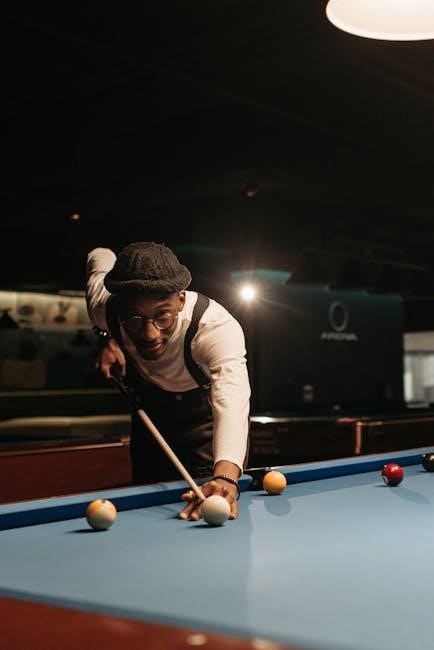
Types of Pool Cues
Pool cues vary in design, material, and length, catering to different playing styles and preferences. Standard cues are the most common, while short cues suit tight spaces. Long cues offer extended reach for larger tables, and specialty cues are crafted for specific games like snooker or carom. Materials range from traditional wood to modern graphite or fiberglass, each providing unique feel and durability. Cue types also differ in weight, balancing power and control to match player needs and skill levels, ensuring optimal performance across various cue sports.
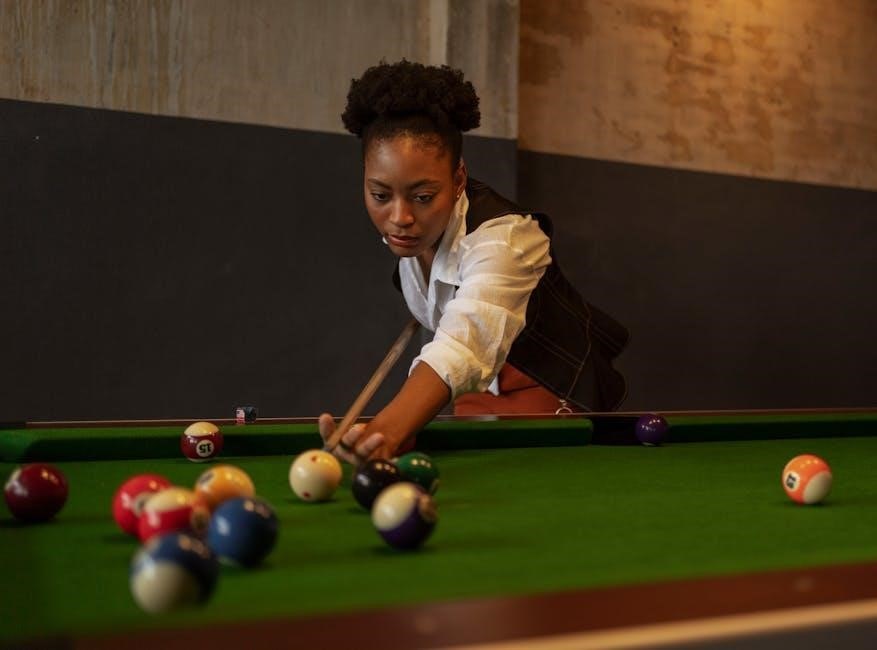
7.1 Standard Cues
Standard pool cues are the most commonly used and versatile option for players. They typically range in length from 57 to 61 inches, with a weight between 18 to 21 ounces. The tip diameter usually measures 12-13 millimeters, providing a balanced feel for various shots. These cues are designed for general play and suit most table sizes. Their moderate length and weight make them adaptable to different playing styles, from casual to competitive. Materials vary, with wood being traditional, while graphite or fiberglass options offer durability. Standard cues are ideal for players seeking a reliable, all-around tool for consistent performance across various games.

7.2 Short Cues
Short pool cues are designed for players who require a more compact tool, typically measuring 48 to 52 inches in length. They are ideal for shorter players, younger enthusiasts, or those with limited arm span. These cues provide better control in tight spaces and are easier to maneuver for players with smaller physical stature. The weight distribution is balanced, usually between 18 to 20 ounces, ensuring accuracy and power in close-range shots.
Short cues are also popular in home environments or smaller tables, where space is limited. Their shorter length allows for precise strikes without compromising leverage. While they excel in confined settings, they may lack the reach and power of standard cues on full-size tables. Short cues are a practical choice for specific needs, offering convenience without sacrificing performance in tight conditions.
7.3 Long and Extra-Long Cues
Long and extra-long pool cues are designed for players who need additional reach and leverage. These cues typically range from 58 to 61 inches in length, with extra-long cues sometimes exceeding 61 inches. They are ideal for taller players, those with a longer wingspan, or for use on larger tables. The extended length provides greater power and accuracy for long-distance shots, making them popular among professional players in competitive environments.
However, long cues can be heavier and more challenging to maneuver in tight spaces. Extra-long cues, while offering maximum reach, may require more strength and precision to control effectively. They are best suited for experienced players who prioritize power and accuracy over portability and ease of handling in confined areas.
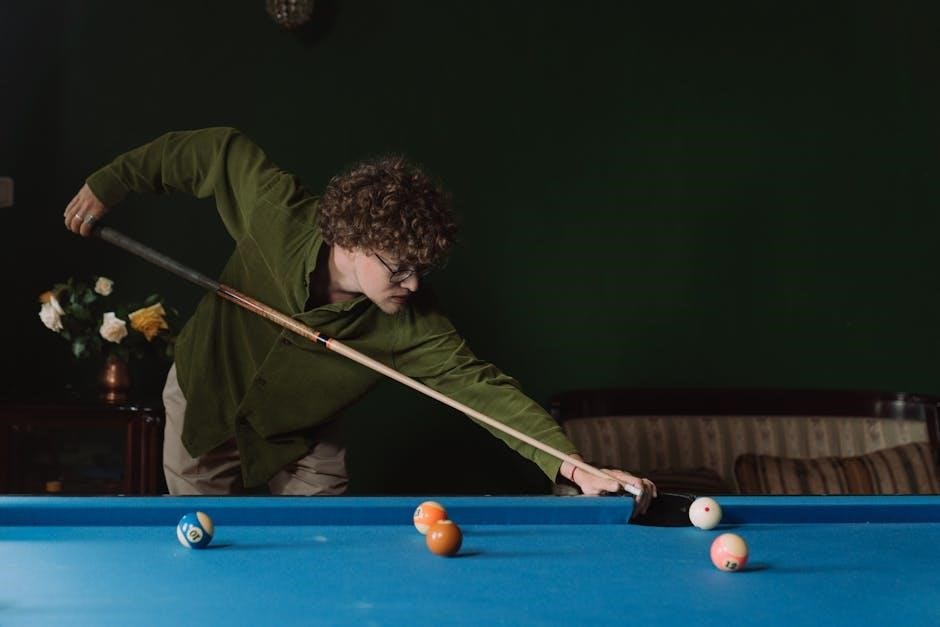
Cue Size for Specific Games
Different cue sports require specific cue sizes for optimal performance. American pool, English pool, and snooker each have unique standards for cue length, tip size, and weight.
Carom games also demand precise cue dimensions to suit the game’s dynamics, ensuring players can achieve the best results in their preferred discipline.
8.1 American Pool Cues
American pool cues are designed for games like 8-ball and 9-ball, typically measuring 57-58 inches in length. They weigh between 18-21 ounces, balancing power and control. The tip diameter ranges from 12-13 millimeters, ideal for the faster-paced nature of American pool. These cues are crafted with maple wood shafts for durability and consistent strike quality. The length and weight are tailored for standard pool tables, which are shorter and wider than snooker tables. Players often prefer a slightly shorter cue for better maneuverability in tight spaces. The balance of the cue is critical, ensuring accuracy and power in shots across the table.
8.2 English Pool and Snooker Cues
English pool and snooker cues are tailored for games played on larger, heavier tables. These cues typically measure 58-61 inches in length and weigh 18-22 ounces, offering a balance of power and control. The tip diameter is smaller, ranging from 9.5 to 10.5 millimeters, to suit the smaller ball sizes and precise aiming required in snooker. The shaft is often made from ash wood, providing a rigid, consistent strike. English cues are designed for longer shots, with a focus on cue ball control and accuracy. The balance point is slightly farther from the tip, enhancing stability for draw and follow shots. This design caters to the strategic, calculated nature of snooker and English pool.
8.3 Carom and Other Cue Sports
Carom and other cue sports require specific cue dimensions to suit the unique demands of the game. Carom cues are typically longer, measuring 58-61 inches, with a lighter weight of 17-19 ounces, allowing for precise control and accuracy. The tip diameter is slightly larger, around 11-12 millimeters, to accommodate the harder strikes often needed in carom. These cues are designed for games like three-cushion billiards, where spin and English are critical. The shaft is often made of graphite or fiberglass for reduced deflection and consistent play. Other cue sports, such as artistic billiards, may use similar specifications, emphasizing balance and responsiveness. The design prioritizes power and control for the intricate shots required in these disciplines. The cue’s overall feel is tailored to the fast-paced, strategic nature of carom and related games.

How to Choose the Right Cue
Choosing the right cue involves measuring your grip and stance, trying different cues, and consulting professionals to ensure comfort, accuracy, and performance tailored to your needs.
9.1 Measuring Your Grip and Stance
Measuring your grip and stance is crucial for selecting a cue that fits your body and playing style. Start by determining your grip size: wrap your hand around the cue shaft, leaving about 1-2 inches of space between your thumb and index finger. For stance, stand naturally with feet shoulder-width apart, knees slightly bent, and cue aligned with your shooting eye. Measure the distance from your grip hand to the cue tip when in shooting position. This ensures proper alignment and balance; A well-fitted cue will enhance accuracy, control, and comfort during gameplay. Always consider your physical posture and how it interacts with the cue’s dimensions.
9.2 Trying Before Buying
Trying before buying is essential to ensure the cue feels right in your hands and suits your playing style. Visit a store with a variety of cues and test them on a table. Pay attention to how the cue balances, its weight distribution, and the feel of the tip. Strike a few balls to assess accuracy and control. A cue that feels natural will improve your performance. If possible, test the cue on a table similar to the one you usually play on. This hands-on approach helps you identify any discomfort or issues before committing to a purchase. Investing time in this step ensures you find a cue that enhances your game;
9.3 Consulting a Professional
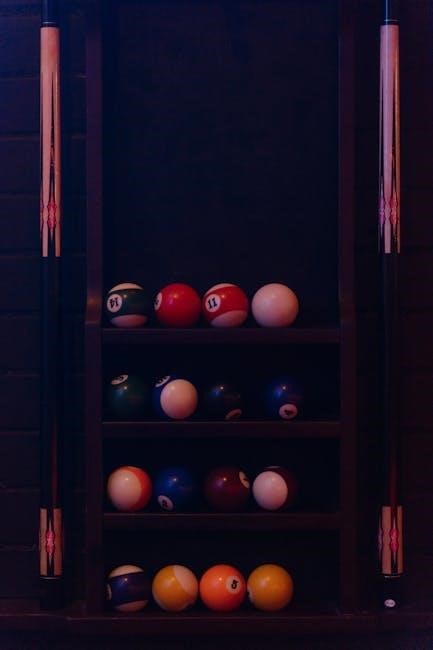
Consulting a professional is a wise step in selecting the right pool cue. Experienced players, coaches, or cue technicians can provide personalized recommendations based on your skills, stance, and playing style. They can assess your grip, posture, and stroke to suggest the ideal cue length, weight, and tip size. Professionals often have extensive knowledge of different materials and constructions, ensuring you find a cue that aligns with your needs. Additionally, they can offer tips on maintenance and customization. Their expertise can save you from costly mistakes and help you invest in a cue that enhances your performance. A professional’s insight is invaluable for both beginners and seasoned players looking to upgrade their equipment.
Selecting the right pool cue size is crucial for optimal performance. Understanding factors like length, weight, and tip size ensures a perfect fit for your game and style.
10.1 Summary of Key Points
10.2 Final Tips for Selecting the Perfect Cue
When choosing a pool cue, prioritize comfort and performance. Ensure the cue length matches your height and stance, while the weight should feel balanced during your stroke. Experiment with different tip sizes to suit your playing style, and consider the table size for optimal accuracy. If possible, try the cue before purchasing to assess its feel and responsiveness. Additionally, seek advice from experienced players or professionals to narrow down your options. Ultimately, the right cue will enhance your game and provide long-term satisfaction. Remember, a well-fitted cue is an investment in your skill development and enjoyment of the sport.
